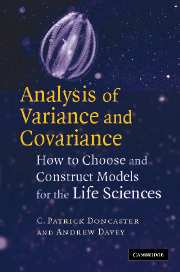Book contents
- Frontmatter
- Contents
- Preface
- Introduction to analysis of variance
- Introduction to model structures
- 1 One-factor designs
- 2 Nested designs
- 3 Fully replicated factorial designs
- 4 Randomised-block designs
- 5 Split-plot designs
- 6 Repeated-measures designs
- 7 Unreplicated designs
- Further Topics
- Choosing experimental designs
- How to request models in a statistics package
- Best practice in presentation of the design
- Troubleshooting problems during analysis
- Glossary
- References
- Index of all ANOVA models with up to three factors
- Index
- Categories of model
2 - Nested designs
Published online by Cambridge University Press: 13 November 2009
- Frontmatter
- Contents
- Preface
- Introduction to analysis of variance
- Introduction to model structures
- 1 One-factor designs
- 2 Nested designs
- 3 Fully replicated factorial designs
- 4 Randomised-block designs
- 5 Split-plot designs
- 6 Repeated-measures designs
- 7 Unreplicated designs
- Further Topics
- Choosing experimental designs
- How to request models in a statistics package
- Best practice in presentation of the design
- Troubleshooting problems during analysis
- Glossary
- References
- Index of all ANOVA models with up to three factors
- Index
- Categories of model
Summary
Nested designs extend one-factor ANOVA to consider two or more factors in a hierarchical structure. Nested factors cannot be cross factored with each other because each level of one factor exists only in one level of another (but see models 3.3 and 3.4 for cross-factored models with nesting). Nested designs allow us to quantify and compare the magnitudes of variation in the response at different spatial, temporal or organisational scales. They are used particularly for testing a factor of interest without confounding different scales of variation. For example, spatial variation in the infestation of farmed salmon with sea lice could be compared at three scales – among farms (A′), among cages within each farm (B′) and among fish within each cage (S′) – by sampling n fish in each of b cages on each of a farms. Similarly, seasonal variation (A) in infestation of farmed salmon by sea lice, over and above short term fluctuations in time (B′), could be measured by sampling n independent fish on b random occasions in each of a seasons.
Designs are inherently nested when treatments are applied across one organisational scale and responses are measured at a finer scale. For example the genotype of a plant may influence the mean length of its parasitic fungal hyphae. A test of this hypothesis must recognise the fact that hyphae grow in colonies (S′) that are nested within leaves (C′), which in turn are nested within plants (B′), which in turn are nested in genotype (A′) (discussed further on page 23).
- Type
- Chapter
- Information
- Analysis of Variance and CovarianceHow to Choose and Construct Models for the Life Sciences, pp. 67 - 75Publisher: Cambridge University PressPrint publication year: 2007



